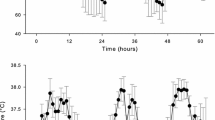Abstract
Assessing temporal changes in anthropometrics and body composition of US Army soldiers is important because these changes may affect fitness, performance, and safety. This study investigated differences in body dimensions (height, weight, percent body fat (%BF)) of US Army male soldiers by comparing 2004 and 1988 databases. Anthropometric somatotypes were identified and physiological responses of the different somatotypes to simulated heat stress (35°C/50%rh, ∼550 W work rate, carrying 12 kg load including battle dress uniform and body armor, rest for 30 min and walk for 70 min) using a thermal regulatory model were evaluated. A significant increase in body weight (2.4 kg) was observed between the 2004 and 1988 data (P < 0.05, after Bonferroni correction). However, changes in height and circumference measurements for %BF were insignificant, with the magnitude of the changes not exceeding inter-observer errors. Multivariate analyses demonstrated that anthropometric distributions did not differ between the two databases and identified five primary somatotypes: “tall-fat”, “tall-lean”, “average”, “short-lean”, and “short-fat.” Within each database, anthropometric values differed among the somatotypes. However, simulated physiological responses to heat stress in each somatotype were similar in the 2004 and 1988 populations. In conclusion, an increase in body weight was the primary change observed in this sample of US Army male soldiers. Temporal changes in somatotypes of soldiers over a 16-year period had minimal impact on simulated physiological response to heat stress using a thermal regulatory model.



Similar content being viewed by others
References
Bathalon G, McGraw S, Friedl K et al. (2004) Rationale and evidence supporting changes to the Army weight control program. USARIEM Technical Report T04–08, Natick
Bray R, Hourani L, Omsted K et al. (2006) 2005 Department of Defense Survey of Health-Related Behaviors Among Active Duty Military Personnel. Research Triangle Institute (RTI) Report No. RTI 7841/106FR, Research Triangle Park
Centers for Disease Control and Prevention (2006) State-specific prevalence of obesity among adults: United State, 2005. Morbidity and mortality weekly report. Atlanta 55:985–988
Centers for Disease Control and Prevention (2002) NIOSH health hazard evaluation report. HETA #2001–0248-2874, Circleville
Department of the Army (1987) The Army weight control program. AR 600-9. Washington, DC
Department of Army (2004) Army demographics. Office of army demographics (OAD) Washington, DC. http://www.armyg1.army.mil/demogrphics
Fogleman M, Bhojani F (2005) Refinery firefighters: assessing fitness for duty. Int J Occup Saf Ergon 11:161–170
Friedl K (2004) Can you be large and not obese? The distinction between body weight, body fat, and abdominal fat in occupational standards. Diabetes Technol Ther 6:732–749
Friedl K, DeLuca J, Marchitelli LJ et al (1992) Reliability of body-fat estimations from a four-compartment model by using density, body water, and bone mineral measurements. Am J Clin Nutr 55:764–770
Frisancho A (1993) Human adaptation and accommodation. The University of Michigan, Ann Arbor
Gordon C, Churchill T, Clauser C et al. (1989) 1988 Anthropometric survey of US Army personnel: methods and summary statistics. TR89/044, US Army Natick Research, Development and Engineering Center, Natick
Gordon C, Bradtmiller B (1992) Interobserver error in a large scale anthropometric survey. Am J Hum Biol 4:253–263
Greiner T, Gordon C (1992) Secular trends of 22 body dimensions in four racial/cultural groups of American males. Am J Hum Biol 4:235–246
Havenith G, Coenen J, Kistemaker L et al (1998) Relevance of individual characteristics for human heat stress response is dependent on exercise intensity and climate type. Eur J Appl Physiol 77:231–241
Hodgdon J, Friedl K (1999) Development of the DoD body composition estimation equations. Naval Health Research Center Report No. 99-2B, San Diego
ISO, International standard (2004) Ergonomics—evaluation of thermal strain by physiological measurements, ISO9886 ISO, Switzerland
Knapik J, Sharp M, Darakjy S et al. (2006) Temporal changes in the physical fitness of U.S. Army recruits. Sports Med 36:613–634
Kraning K, Gonzalez R (1997) A mechanistic computer simulation of human work in heat that accounts for physical and physiological effects of clothing, aerobic fitness, and progressive dehydration. J Therm Biol 22:331–342
Pandolf K, Givoni B, Goldman R (1977) Predicting energy expenditure with loads while standing or walking very slowly. J Appl Physiol 43:577–581
Ruff C (2000) Body size, body shape, and long bone strength in modern humans. J Hum Evol 38:269–290
Shapiro Y, Pandolf K, Avellini B et al. (1980) Physiological responses of men and women to humid and dry heat. J Appl Physiol 49:1–8
Sharp M, Patton J, Knapik J et al. (2002) Comparison of the physical fitness of men and women entering the U.S. Army: 1978–1998. Med Sci Sports Exerc 34:356–363
Sawka M, Latzka W, Montain S et al. (2000) Physiologic tolerance to uncompensable heat: intermittent exercise, field vs. laboratory. Med Sci Sports Exerc 33:422–430
STATA (2003) STATA Release 8.0. College Station, Stata Cooperation
Tatsuoka M (1988) Multivariate analysis: techniques for educational and psychological research. Macmillan publishing company, NY
Westerstahl M, Barnekow-Bergkvist M, Hedberg G, Jansson E (2003) Secular trends in body dimensions and physical fitness among adolescents in Sweden from 1974 to 1995. Scand J Med Sci Sports 13:128–137
Acknowledgments
The authors would like to thank Dr. C. Gordon, Natick Soldier Research Development and Engineering (NSRDE) and COL K. Friedl, Telemedicine and Advanced Technology Research Center (TATRC) for the datasets. The authors also thank Dr. W. Santee and Dr. R. Hoyt, USARIEM, for critical comments on this paper, and Mr. Julio Gonzalez (USARIEM) for generating computer graphics.
Author information
Authors and Affiliations
Corresponding author
Additional information
Disclaimer: The investigators have adhered to the policies for protection of human subjects as prescribed in Army Regulation 70-25, and the research was conducted in adherence with the provisions of 32 CFR Part 219. The opinions or assertions contained herein are the private views of the author(s) and are not to be construed as official or reflecting the views of the Army or the Department of Defense.
Rights and permissions
About this article
Cite this article
Yokota, M., Bathalon, G.P. & Berglund, L.G. Assessment of male anthropometric trends and the effects on simulated heat stress responses. Eur J Appl Physiol 104, 297–302 (2008). https://doi.org/10.1007/s00421-007-0656-8
Accepted:
Published:
Issue Date:
DOI: https://doi.org/10.1007/s00421-007-0656-8




